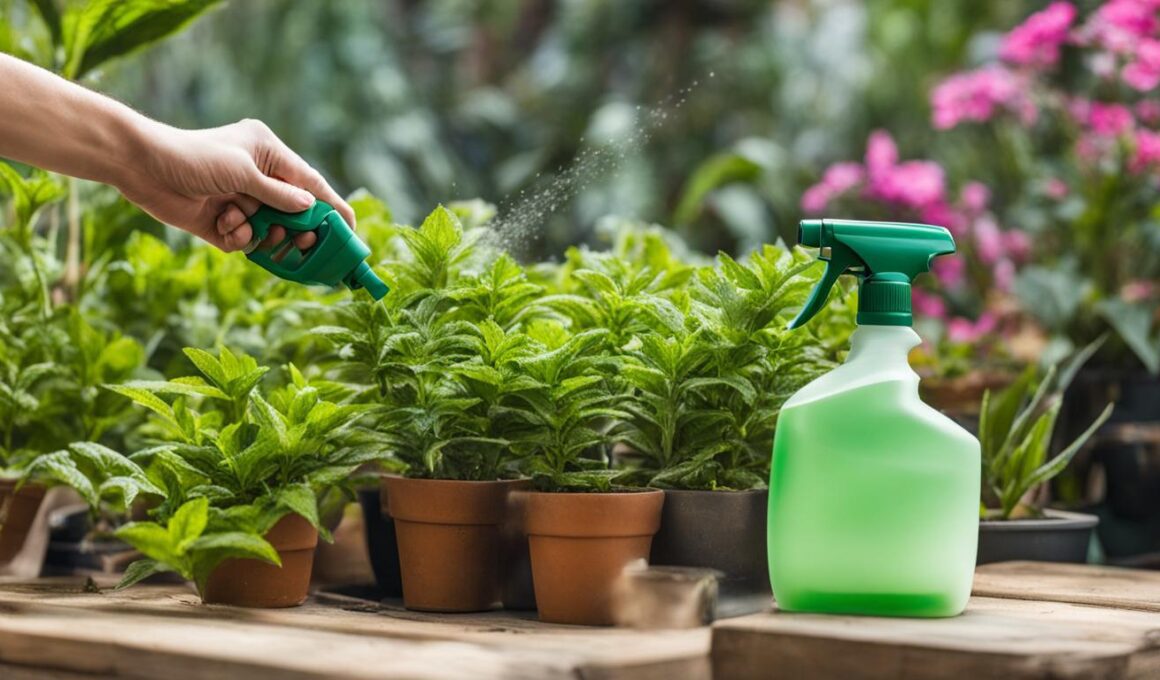Downey mildew is a harmful umbrella term for a variety of plant diseases caused by water molds. It attacks vegetables, fruits, and flowers, and once symptoms appear, it is usually too late to save the plant. Prevention is crucial in combating downy mildew, as it can devastate crops and cause economic losses. In this article, we will explore effective strategies to fight against downey mildew and ensure the optimal health of your plants.
Key Takeaways:
- Downey mildew is caused by water molds and can be devastating to crops.
- Prevention is key in combating downey mildew.
- Regular scouting, using resistant cultivars, and maintaining good air circulation are effective preventive measures.
- Control methods include the use of fungicides and organic alternatives.
- By implementing these strategies, gardeners can effectively manage downey mildew and ensure a healthy garden.
Understanding Downy Mildew: Causes and Symptoms
Downy mildew is a destructive plant disease caused by water molds known as oomycetes. This parasitic fungus thrives on living plants and can cause widespread damage if left unchecked. Understanding the causes and symptoms of downy mildew is crucial in identifying and combatting this plant disease.
One of the main causes of downy mildew is high humidity combined with moderate temperatures. These favorable conditions create an ideal environment for the growth and spread of the fungus. Additionally, the presence of infected plants and the movement of wind or water can contribute to the transmission of downy mildew.
Symptoms of downy mildew may vary depending on the host plant, but there are common signs to look out for. Infected plants typically develop yellow spots on the leaf surface between the veins, which eventually turn brown. This discoloration is due to the fungus inhibiting the plant’s ability to photosynthesize. In some cases, a fuzzy growth may appear on the underside of the leaves, indicating the presence of downy mildew.
By promptly identifying the causes and symptoms of downy mildew, you can take effective measures to prevent its spread and protect your plants. Regular monitoring and early detection are essential in maintaining the health and vitality of your garden.
Life Cycle and Disease Transmission
Understanding the life cycle and disease transmission of downy mildew is crucial in effectively combating this harmful plant disease. By gaining insight into how this fungus spreads, you can implement preventative measures to protect your plants.
The life cycle of downy mildew starts with overwintering as mycelium or oospores on or inside the host plant. When favorable conditions of temperature and humidity occur, the oospores germinate and produce sporangiophores. These structures release sporangia, which contain zoospores. These zoospores are then carried by wind or water to new plants, where they germinate and infect the host.
In addition to wind and water, downy mildew can also spread through the use of tools or hands that come into contact with infected plants. This means that proper sanitation practices, such as disinfecting gardening tools and washing hands thoroughly, are essential in preventing the spread of the disease.
To summarize, the life cycle of downy mildew involves overwintering as mycelium or oospores, the production of sporangiophores and sporangia, and the transmission of zoospores through wind, water, and contact. By understanding these transmission pathways, you can take proactive steps to minimize the risk of downy mildew spreading to your plants.
| Phase | Description |
|---|---|
| Overwintering | Mycelium or oospores survive on or inside the host plant. |
| Growth and Spore Release | Favorable conditions trigger the germination of oospores, resulting in the production of sporangiophores that release sporangia. |
| Transmission | The sporangia, containing zoospores, are transported by wind, water, or contact to new plants, where they infect the host. |
Important Strains of Downy Mildews
Downy mildews are caused by various strains of water molds and can have a significant economic impact on specific plants. Understanding these important strains is essential for effective management and prevention of downy mildew in your garden.
One of the most devastating strains of downy mildew is cucurbit downy mildew, which affects cucumber, melon, gourds, pumpkin, and squash. This strain can quickly decimate entire crops, leading to substantial economic losses for commercial growers and home gardeners alike.
Other notable strains include grape downy mildew, basil downy mildew, hops downy mildew, impatiens downy mildew, rose downy mildew, spinach downy mildew, and sunflower downy mildew. Each of these strains targets specific plants and can cause significant damage if left untreated.
To effectively combat downy mildew, it is crucial to identify the specific strain affecting your plants and implement appropriate prevention and control strategies. By staying aware of the prevalence and impact of these strains, you can take proactive measures to protect your garden from the devastating effects of downy mildew.
| Strain | Affected Plants |
|---|---|
| Cucurbit Downy Mildew | Cucumber, Melon, Gourds, Pumpkin, Squash |
| Grape Downy Mildew | Grapevine |
| Basil Downy Mildew | Basil |
| Hops Downy Mildew | Hops |
| Impatiens Downy Mildew | Impatiens |
| Rose Downy Mildew | Roses |
| Spinach Downy Mildew | Spinach |
| Sunflower Downy Mildew | Sunflower |
Prevention Strategies for Downy Mildew
Prevention is crucial when it comes to effectively managing and combating downy mildew. By implementing a few simple yet effective measures, you can significantly reduce the risk of infection and ensure the optimal health of your plants.
1. Use Resistant Cultivars
One of the most effective ways to prevent downy mildew is by selecting and using plant varieties that are resistant to the disease. Resistant cultivars have built-in genetic traits that make them less susceptible to infection. When choosing cultivars, look for those specifically bred to have resistance to downy mildew. This proactive approach can significantly reduce the likelihood of an outbreak in your garden.
2. Regular Scouting and Removal
Frequent scouting of your plants is essential to quickly identify any signs of downy mildew. Inspect both the upper and lower surfaces of leaves for yellow or brown spots, fuzzy growth, or any other unusual symptoms. If you spot any infected plants, remove them immediately to prevent the spread of the disease. Proper disposal of infected plant material is crucial to prevent recontamination, so make sure to bag and discard it in a way that ensures it won’t come into contact with other plants or soil.
3. Maintain Good Air Circulation
Downy mildew thrives in humid and stagnant conditions, so it’s important to maintain good air circulation in your garden. Properly space your plants to provide adequate airflow between them. Prune dense foliage to improve ventilation and remove any dead or decaying plant material that can harbor the disease. By creating an environment with good airflow, you reduce the chances of moisture accumulation and create less favorable conditions for downy mildew to take hold.
4. Proper Watering Practices
The way you water your plants can also play a role in preventing downy mildew. Avoid overhead irrigation, as it can increase humidity levels and create a favorable environment for the disease. Instead, opt for drip irrigation or watering at the base of plants to minimize moisture on the leaves. Water in the early morning so that foliage has time to dry before evening when temperatures drop. Consistent moisture management can help deter the development and spread of downy mildew.
| Prevention Strategies for Downy Mildew | Effectiveness |
|---|---|
| Use Resistant Cultivars | High |
| Regular Scouting and Removal | High |
| Maintain Good Air Circulation | Medium |
| Proper Watering Practices | Medium |
Implementing these prevention strategies and practicing good garden hygiene can significantly reduce the risk of downy mildew in your plants. Combine these measures with other control methods such as crop rotation, proper fertilization, and maintaining a healthy soil ecosystem to further enhance your plant’s resistance to this troublesome disease.
Control Methods for Downy Mildew
Combatting downy mildew requires effective control methods to inhibit the spread of the disease and protect your plants. Fungicides play a vital role in managing downy mildew outbreaks, and their application should be prioritized during periods of high humidity and mild temperatures. Choose fungicides that are specifically formulated to target downy mildew and follow the recommended application rates and timings.
In addition to fungicides, organic control methods can be employed to manage downy mildew in a sustainable and environmentally friendly manner. Copper-based fungicides, such as copper hydroxide or copper sulfate, have been proven effective against downy mildew on certain crops. These can be applied preventatively or as soon as symptoms are detected. Neem oil, derived from the neem tree, is another organic option that can be used to control downy mildew. It works by disrupting the growth and reproduction of the fungus, providing effective protection for your plants.
Furthermore, the use of Bacillus subtilis, a naturally occurring bacterium, has shown promise in controlling downy mildew. Bacillus subtilis works by colonizing the surface of plant tissues, forming a protective barrier against pathogens, including downy mildew. Incorporating this beneficial bacterium into your plant care routine can help suppress disease development and promote plant health.
“Effective control of downy mildew involves a proactive and integrated approach. Combining cultural practices, such as proper pruning and irrigation techniques, with targeted fungicide applications can significantly reduce the impact of this disease on your plants.”
– Plant Pathologist
Table: Comparison of Control Methods for Downy Mildew
| Control Method | Advantages | Disadvantages |
|---|---|---|
| Fungicides | – Provides quick and effective control – Wide range of available products – Specific formulations for different crops and downy mildew strains |
– Potential environmental impact – Risk of resistance development – Application timing and rates require careful monitoring |
| Copper-based fungicides | – Organic control option – Broad-spectrum activity – Preventative and curative action |
– Can cause phytotoxicity at higher concentrations – Accumulation of copper in soil over time |
| Neem oil | – Organic control option – Disrupts fungal growth and reproduction |
– Application frequency may be required – May have limited efficacy against certain strains |
| Bacillus subtilis | – Biological control option – Promotes plant health and disease suppression |
– Variable effectiveness against different downy mildew strains – Requires consistent application and colonization |
When employing any control method for downy mildew, it is important to follow the manufacturer’s instructions carefully. Monitor your plants regularly for signs of disease and adjust your control strategies accordingly. By implementing an integrated approach that combines cultural practices, fungicides, and organic options, you can effectively manage downy mildew and safeguard the health of your plants.
Can Downey Mildew Affect the Soil Needed for Plant Pots?
Yes, downy mildew can affect the soil needed for pot plants. This fungal disease thrives in damp conditions, causing damage to the soil and plant roots. It’s important to keep an eye on the soil quality and take steps to prevent downy mildew from spreading to your potted plants.
Conclusion
Downy mildew management is crucial for the effective strategies against downey mildew and the overall health of your garden plants. By understanding the causes, symptoms, and life cycle of downy mildew, you can take proactive steps to combat this pesky fungus.
Regularly scouting your plants for symptoms is essential in catching and removing infected plants promptly, preventing the spread of the disease to healthy plants. Additionally, using resistant cultivars whenever possible can decrease the risk of infection and minimize the impact of downy mildew on your garden.
Maintaining good air circulation by pruning and spacing your plants appropriately creates unfavorable conditions for downy mildew growth. This simple step can significantly reduce the risk of infection. Proper watering practices, such as avoiding overhead irrigation and using drip irrigation, also play a vital role in preventing the disease.
In cases where preventive measures are not sufficient, consider the use of fungicides. Apply them preventatively during periods of high humidity and mild temperatures. Be sure to rotate fungicides to prevent the development of resistance. For organic options, copper fungicides, neem oil, and Bacillus subtilis can be used, but always follow specific precautions when employing these products.
By following these effective strategies against downey mildew, you can ensure the garden plant health and enjoy a thriving, disease-free garden. Take action today to protect your plants and preserve their beauty!
FAQ
What are the symptoms of downy mildew?
The symptoms of downy mildew include yellow spots on the leaf surface between the veins, which eventually turn brown. The plants may also have a fuzzy growth on the bottom of the leaf surface.
How does downy mildew spread?
Downy mildew can spread through wind, water, and contact with infected plants. Tools and hands that come into contact with infected plants can also spread the disease.
Which plants are susceptible to downy mildew?
Downy mildew can affect a wide range of plants, including cucumbers, melons, gourds, pumpkins, squash, cabbage, broccoli, grapes, basil, hops, impatiens, roses, spinach, and sunflowers.
How can I prevent downy mildew?
To prevent downy mildew, you can use resistant cultivars, regularly scout for infected plants and remove them, maintain good air circulation, practice proper watering techniques, eliminate overwintering sites, and quarantine new plants.
What control methods are effective against downy mildew?
Fungicides can be used to control downy mildew, and they should be applied preventatively during periods of high humidity and mild temperatures. Organic control methods such as copper fungicides, neem oil, and Bacillus subtilis are also available for certain plants.











